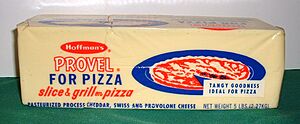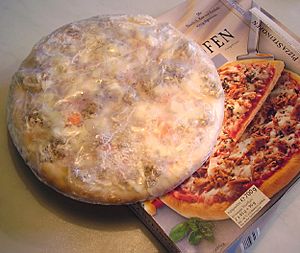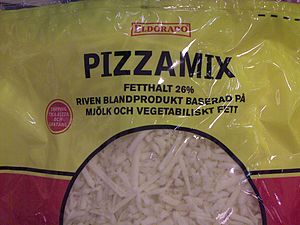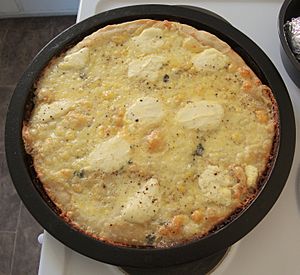Pizza cheese facts for kids

Pizza cheese is a special kind of cheese made just for pizza. It includes many different types of cheeses and dairy products. Some are natural cheeses, while others are changed or "processed" to be perfect for pizza.
This special cheese is made to melt well and turn golden brown. It also needs to stretch nicely when you pull a slice! Scientists and cheesemakers have done lots of research. They want to make the best and most affordable pizza cheese.
The most popular cheese for pizza is mozzarella. About 30% of all pizza cheese used is mozzarella! Other popular choices include provolone, cheddar, and Parmesan. Some cheeses like Emmental, Romano, and ricotta are also used.
In 1997, people in the United States made about 2 billion pounds of pizza cheese. Europe made 200 million pounds! The demand for pizza cheese kept growing in the early 2000s.
Contents
What Makes Pizza Cheese Special?

The International Dictionary of Food and Cooking says pizza cheese is a soft cheese. It's like mozzarella but has a bit less water. Most pizza cheeses are at least 95% mozzarella. They just have different amounts of water and fat.
For frozen pizzas, cheese might be "comminuted." This means it's cut into tiny pieces or granules. Low-moisture mozzarella is made especially for pizza. It's firmer than regular mozzarella. This makes it easier to grate and helps it brown better. It also lasts longer!
Often, pizza cheese is a mix of two or more cheeses. A common mix is low-moisture mozzarella and provolone. Low-moisture mozzarella was first made in the Midwest United States. People even called it "pizza cheese" back then!
Different Kinds of Pizza Cheese
Around the world, mozzarella is the most popular cheese for pizza. But in the United States, only about 30% of pizza cheese is pure mozzarella. Provolone is the second most popular.
Sometimes, cheddar is mixed with mozzarella. This helps the pizza stay chewy. Grated Parmesan is often sprinkled on top. It usually doesn't melt much when cooked.
Many different kinds of processed pizza cheeses are made. These are sometimes called "analogue" cheeses. Provel is one example. Other cheeses used include Emmental and Romano. Detroit-style pizza often uses Wisconsin brick cheese. Ricotta cheese is used for calzones or as a topping.
Mixing different cheeses can change how they brown. For example, mozzarella and cheddar might not blister as much. This is because cheddar is less stretchy. Mozzarella and provolone might not brown as much as other mixes.
Processed Pizza Cheeses
Many pizzas you buy in stores, especially frozen ones, use processed cheese. These cheeses are quicker and cheaper to make. They melt well and stay chewy. They are called "analogue pizza cheese." In the UK, they are called "cheese analogue" to show they are not real cheese.
These analogue cheeses are the most common type of "cheese analogue" made worldwide. In the United States, 700 million frozen pizzas are sold each year. About three-quarters of them use these cheese substitutes!
Analogue pizza cheeses can be made with simpler equipment. They often have a soft texture. When melted, they can be a bit "stringy" when you pull them. They might not melt together as smoothly as real cheese. New ingredients have been made to help these cheeses melt better.
Provel cheese is a processed pizza cheese. It uses cheddar, Swiss, and Provolone for flavor. Some analogue cheeses are made with casein. Casein is a milk by-product. They use vegetable oil instead of milk fat.
Making analogue pizza cheese can be similar to making cream cheese. The mix is heated to a certain temperature. This makes the proteins in the mix turn into a gel. Salts in the mix help it melt better. The hot cheese is then put into bags or boxes. It's cooled quickly to stop it from browning too much.
Improving Pizza Cheese
Cheesemakers and scientists are always trying to make pizza cheese better. They want to improve how it stretches, melts, and browns. They also study its fat and water content. Many special types of pizza cheese have patents.
One study found that adding a thin layer of vegetable oil to low-fat pizza cheese helped it melt more. It also browned less. But the cheese still felt too chewy. Other studies found ways to make low-fat pizza cheese melt better. This included adding more moisture or using special ingredients.
Manufacturers aim for pizza cheese to have 50-52% moisture. They also want 35-40% fat in the dry part of the cheese. One study found that mixing a small amount of vetch milk with cow's milk improved stretchiness. Vetch is a plant with seeds like lentils.
Another study looked at reducing galactose in cheese. Galactose is a sugar that is less sweet than glucose. They found different ways to do this using special cultures. Adding trisodium citrate, a food additive, also slightly improved pizza cheese.
Some people prefer pizza cheese that doesn't brown as much. This can be done with low-moisture mozzarella that has less galactose. Some types of mozzarella are made so they don't need to age. Others can be made by directly adding acid to milk instead of using bacteria.
Making and Selling Pizza Cheese
In the United States, people started eating more mozzarella and pizza cheese in the mid-1900s. This trend has continued into the 2000s. Hundreds of millions of pounds of pizza cheese are eaten every year in the U.S.
In 1997, the U.S. made 1 million tons of pizza cheese. Europe made 100,000 tonnes. By 2000, the demand for pizza cheese in Europe was growing by 8% each year!
Big food companies and quick service restaurants use mass-produced pizza cheese. The world's largest pizza cheese maker is Leprino Foods Company. They process 600,000 tonnes of cheese every year! Leprino Foods has patents for special ways to make mozzarella quickly. They can make frozen shredded cheese for pizza in just a few hours from milk.
Other U.S. companies also make lots of pizza cheese. It is often shipped frozen. As of 2000, Glanbia was the biggest producer of pizza cheese in Europe. Some frozen pizzas even have cheese stuffed into the crust!
Where is Pizza Cheese Used?
Lots of pizza cheese is used in Europe, Australia, New Zealand, and the United States. In the U.S., whole milk mozzarella is popular in the East and Southwest. A survey showed that provolone was more popular on the East and West coasts.
Cheddar cheese might be used more in the Eastern and Southern parts of the U.S. Provel cheese is a special type of cheese. It is commonly used to make St. Louis-style pizza in the U.S.



